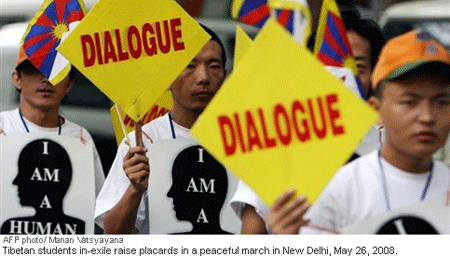by Tsering Topgyal
On April 25, China offered to hold “contact and consultation with Dalai Lama’s private representative.” Western governments heaved a collective sigh of relief. The 2008 U.S.-EU Summit declaration, for instance, welcomed China’s gesture, calling for a “results-orientated dialogue.” Experience has taught the Tibetans to be more guarded. The Dalai Lama welcomed “serious” talks, not empty gestures. Tibet’s Prime Minister in-exile Samdhong Rinpoche, called China’s original offer a “good sign,” but on June 8 he saw “very little chance of an agreement with China on core issues.”

Circumspection is warranted. Beijing keeps stating preconditions that the Dalai Lama has repeatedly addressed. He denied seeking independence, opposed violence and supported the Beijing Olympics. Meanwhile, on April 30, the state-run China Daily said the Dalai Lama “is spewing lies.” On June 7, the Communist Party’s People’s Daily claimed he “planned” the Tibetan uprising and infected monks who allegedly caused explosions in Chamdo with “separatist thoughts.” Further, Beijing has delayed the seventh round of talks scheduled for June 11, citing earthquake relief work. Yet Beijing just hosted Russian President Medvedev, among others, so it’s something of a mystery why three or four Tibetans in Beijing would get in the way of relief work in Sichuan.
Is Beijing interested in serious dialogue? This is an important question because when raised expectations are dashed, dialogue becomes dangerous. When talks are on the horizon, Tibetans think that deliverance from political powerlessness, cultural depression and economic marginalization is close. The possibility of being united with the Dalai Lama lifts their sunken spirits. Past experience suggests that failed dialogue provokes Tibetan protests.
Between 1987 and 1992, Lhasa was rocked by 140 protests and riots; martial law was imposed in Lhasa in 1989. Many Tibetans paid with their lives, others spent years in prison or labor camps. The protests took place after the Sino-Tibetan dialogue that began in 1978 collapsed.
Four exile fact-finding missions and two exploratory talks took place between 1979 and 1985. Dialogue failed as a result of widely divergent positions, but the balance of compromise favored Beijing. The Dalai Lama controversially gave up independence for autonomy, while Beijing simply denied the existence of a Tibet issue.
The euphoria of renewed links with the Dalai Lama and promise of greater autonomy, palpable in the early 1980s, gave way to despair and anger as talks floundered and Beijing saw economic development as a panacea for Tibetan grievances. In 1984, Tibet was opened for Chinese migration despite the reservations of leading Tibetan cadres. The influx of Chinese caused great resentment. More fundamental political, cultural and economic reasons existed, but the failure of talks and the dashing of hopes clearly contributed to the protests.
The recent and ongoing round of over 100 riots and protests is no exception. A sense of political hopelessness and cultural depression had gripped the Tibetan psyche in the face of hard-line policies, Chinese migration and the continued exile of the Dalai Lama. Even in heavily censored blogs and popular media from Tibet, the Dalai Lama’s exile and the fate of Tibetan identity under Chinese political and cultural imperialism are lamented at great risk.
Against this backdrop of despair, dialogue resumed in September 2002, raising Tibetan hopes again. Immediately, Beijing indicated that it was not interested in meaningful negotiations. The Dalai Lama’s representatives were not formally recognized and his scaled-down Middle Way policy was derided. In 2005, Zhang Qingli, Tibet’s Party Secretary, stepped up the anti-Dalai lama campaign calling him a “false religious leader.” On Sept. 30, 2006, Chinese troops shot dead two Tibetans escaping across the Himalayas.
On July 18, 2007, Beijing announced “Order No. 5” prohibiting Tibetan lamas from reincarnating without “prior approval” from Beijing. As ludicrous as this sounds, it’s clear that Beijing has the selection of the next Dalai Lama in mind. Not surprisingly, Tibetan resentment grew.
After six rounds of dialogue, which the Tibetans handled with great delicacy, nothing was achieved. The Dalai Lama conceded on March 10, 2008, that “on the fundamental issue, there has been no concrete result.” For the next several days monks and nuns in Lhasa demonstrated peacefully, but were beaten up and arrested.
On March 14, some protestors turned violent and attacked symbols of Chinese colonialism (not of capitalism or modernity as leftist pundits are trying to portray), including Chinese migrants.
Through their actions and written and verbal slogans, the protestors were reinforcing and reiterating the Dalai Lama’s positions. Clearly, the stalled dialogue with Beijing was in their minds. Sadly, due to the Chinese authorities’ brutal crackdown, many paid with their lives and livelihoods.
In light of such suffering, it would be extremely irresponsible for Beijing to initiate another round of dialogue without honestly addressing longstanding Tibetan grievances. As things stand, dialogue appears to be little more than a PR gimmick to improve Beijing’s image in the world. Beijing needs to understand that failed dialogue is as explosive as no dialogue at all. Remember the protests of March, President Hu. Remember the Tibetans and Chinese immigrants who died. Dialogue must now be received with as much trepidation as relief.
(This article is reproduced from Far Eastern Economic Review. Tsering Topgyal, a Tibetan, is writing a doctoral dissertation on the Sino-Tibetan conflict at the London School of Economics. The views expressed here are solely those of the author, they do not reflect those of the Central Tibetan Administration)
